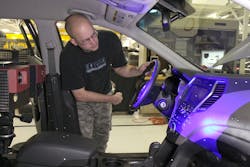GM taps digital tools to dissect competitive products
A variety of digital tools are being deployed by General Motors to “surgically dissect” competitor vehicles, said Larry Pecar, senior supervisor for GM’s competitive benchmarking team – with the team conducting such “surgery” about three dozen times a year globally with models strategically selected that are all-new or feature industry-first systems and technologies.
Light scanners mathematically capture precise 3-D images of vehicle structures and components, he explained, with complete sets of scans becoming “reverse-engineered” computer models so they can be matched up against GM’s designs.
The lessons learned from such comparisons drive cost and mass reductions as well as quality improvements in Chevrolet, Cadillac, Buick and GMC vehicles with each model year, noted Pecar, with his team also dismantling and scanning GM vehicles to validate parts, quality check manufacturing processes and troubleshoot part irregularities.
“3-D scanning is a time-efficient and cost-effective way of keeping up with rapid advancements being made all over the industry,” he pointed out. “The technology also allows us to gain a better understanding of the reasons for other automakers’ recalls so that we are better able to avoid making the same mistakes."
GM’s 3-D scanning system – used by the OEM for well over a decade now – projects a red, white or blue light pattern onto the vehicle surface while an advanced camera or sensor captures its contours and records where the object is in space and its orientation.
While any one of these systems can scan small parts to complete vehicles, blue and white light works best at capturing complete vehicle scans, including full exterior surfaces, Pecar said.
Blue light scanners map vehicle interiors and locations of under hood and under body components, while red light scanning is best for capturing details of components and parts already removed from vehicles. White light scanning, however, is “older technology” and is used less frequently due to the advanced capability of blue light scanning.
By combining data from red and blue light scans, engineers can capture stand-alone parts and their original position and orientation within the vehicle, Pecar noted.
“By comparing the scan of a finished product to the original math model we can identify the source of fit and finish problems. In some cases even squeaks and rattles can be avoided or quickly addressed,” he explained. “There is no place for a quality issue to hide.”
About the Author
Fleet Owner Staff
Our Editorial Team
Kevin Jones, Editorial Director, Commercial Vehicle Group
Cristina Commendatore, Executive Editor
Scott Achelpohl, Managing Editor
Josh Fisher, Senior Editor
Catharine Conway, Digital Editor
Eric Van Egeren, Art Director
